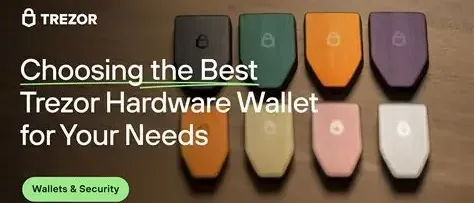Trezor Bridge® | Connect Your Trezor to Web Browsers

Trezor Bridge® – A Modern Gateway for Connecting Your Trezor Wallet to Web Browsers
In today’s rapidly evolving digital landscape, secure management of cryptocurrencies has become a priority for anyone interacting with blockchain assets. As decentralized applications expand and hardware wallets gain mainstream acceptance, the tools that enable seamless communication between devices and browsers must evolve as well. Trezor Bridge® stands out as a crucial component in this infrastructure. It functions as the communication link that allows your Trezor hardware wallet to interact effortlessly with supported browsers and wallet interfaces. Without it, many websites and crypto dashboards would be unable to detect your device, limiting your ability to send, receive, or manage digital assets securely.
This article explores what Trezor Bridge is, how it works, why it matters, and what benefits it delivers to users who rely on hardware-based protection for their cryptocurrencies. Designed to provide a fully new and comprehensive understanding, this guide presents an in-depth overview suitable for beginners and experienced users alike.
Understanding What Trezor Bridge® Is
Trezor Bridge is a lightweight background application developed by SatoshiLabs, the creators of Trezor hardware wallets. While Trezor devices provide offline protection for private keys, the Bridge enables communication between the physical device and any web-based wallet interface such as Trezor Suite Web.
Before the Bridge existed, browser extensions were required for hardware wallet interaction. As browser security models shifted, extensions became less practical and were gradually phased out. Trezor Bridge replaced this outdated method with a more stable and universal solution capable of working across major operating systems and modern web browsers.
When installed, Trezor Bridge operates quietly without needing regular attention. It establishes secure, encrypted communication pathways between your device and your chosen browser environment, making sure commands are delivered reliably and safely.
Why Trezor Bridge® Matters
Hardware wallets are designed to store private keys offline, separating them from potentially compromised computers, malware, or browser-based risks. However, this layer of physical security requires a trustworthy communication method when users want to interact with online services.
Trezor Bridge addresses several key challenges:
1. Secure Connectivity
Browsers block direct communication with USB devices for safety reasons. Trezor Bridge bypasses these restrictions using authenticated communications, ensuring only approved sites or applications can request access to your Trezor.
2. Reliability Across Browsers
Rather than depending on browser extensions that must be updated or may face deprecation, the Bridge functions independently. Whether the user prefers Chrome, Firefox, Edge, or another supported browser, the interaction remains consistent.
3. High Compatibility
The Bridge supports Windows, macOS, and Linux, making it flexible for different environments. Whether you use a desktop workstation or a lightweight laptop, your Trezor functions smoothly.
4. Better User Experience
Users don't need to configure complicated settings. Once installed, the Bridge runs automatically in the background and allows browsers to detect the device instantly.
How Trezor Bridge® Works
The Bridge serves as an intermediary service. When you connect your Trezor wallet via USB, the browser communicates not directly with the hardware but with this background application. It then sends instructions to the device and retrieves responses.
For example, when you confirm a transaction:
- The website interface sends a request through your browser.
- The browser forwards the request to the Trezor Bridge.
- The Bridge passes the instruction to the Trezor device.
- The device displays transaction details on its secure screen.
- You verify and approve or reject the request.
- The signed transaction is transmitted back through the Bridge to the browser interface.
This ensures that private keys never leave the hardware wallet, while the Bridge only handles encrypted messages. Even if the computer were compromised, an attacker would still need physical access to the device and user confirmation to perform any action.
Installing Trezor Bridge®
The installation process is straightforward:
- Download the official installer from the Trezor website.
- Run the installation package and follow the prompts.
- Restart your browser once the installation finishes.
- Connect your Trezor device.
- Open a Trezor-supported wallet interface such as Trezor Suite Web.
Upon launching the interface, the Bridge enables your browser to detect the device automatically. No manual configuration is required after installation.
Features and Advantages of Trezor Bridge®
Enhanced Security Protocols
The Bridge is built around robust communication standards. Each request between the wallet interface and device is authenticated, ensuring malicious sites cannot trick your hardware wallet into processing unauthorized actions.
Future-Proof Design
Browser environments frequently change due to evolving security models. Instead of relying on browser-specific processes, the Bridge works at the system level, making it resilient against browser updates that would otherwise break compatibility.
Lightweight and Efficient
The application is engineered to have minimal system impact. It doesn’t consume significant memory or processing power and runs silently in the background without unnecessary interruptions.
Streamlined Device Setup
During onboarding, the Bridge assists users in initiating firmware updates, creating new wallets, recovering existing ones, or configuring PIN protection.
Universal Communication Layer
Whether you are accessing decentralized finance platforms, verifying payment addresses, or managing multiple assets, the Bridge ensures that every command travels through a trusted, verifiable pathway.
Who Should Use Trezor Bridge®?
Trezor hardware wallets are used by investors, traders, developers, and everyday crypto holders. The Bridge enhances their experience, making it indispensable for:
- Individuals managing long-term digital assets
- Traders using online exchanges that require wallet verification
- Developers integrating Trezor support into crypto applications
- Users interacting with DeFi platforms or Web3 interfaces
- Anyone who values secure, smooth device-to-browser communication
If you depend on your Trezor for safeguarding digital currencies, the Bridge is a required component that enriches usability and protects the integrity of transactions.
Maintaining and Updating Trezor Bridge®
SatoshiLabs periodically releases updates to improve performance, maintain compatibility, and address security enhancements. The Bridge may notify you when an update becomes available. Installing these updates ensures continued functionality and compatibility with new browser and OS releases.
Updating is as simple as downloading the latest version and installing it over the existing one.
Conclusion
Trezor Bridge® is far more than a background connector—it is a crucial part of maintaining secure, reliable interaction between your Trezor hardware wallet and modern web browsers. By providing a trusted and efficient communication layer, the Bridge strengthens the overall security of your digital asset management.
Its combination of ease of use, robust protection, cross-platform support, and future-proof architecture makes it a foundational element in the Trezor ecosystem. Whether you are a beginner exploring the world of cryptocurrencies or an experienced user handling substantial digital portfolios, Trezor Bridge ensures your hardware wallet remains functional, secure, and seamlessly integrated with the web interfaces you rely on.
